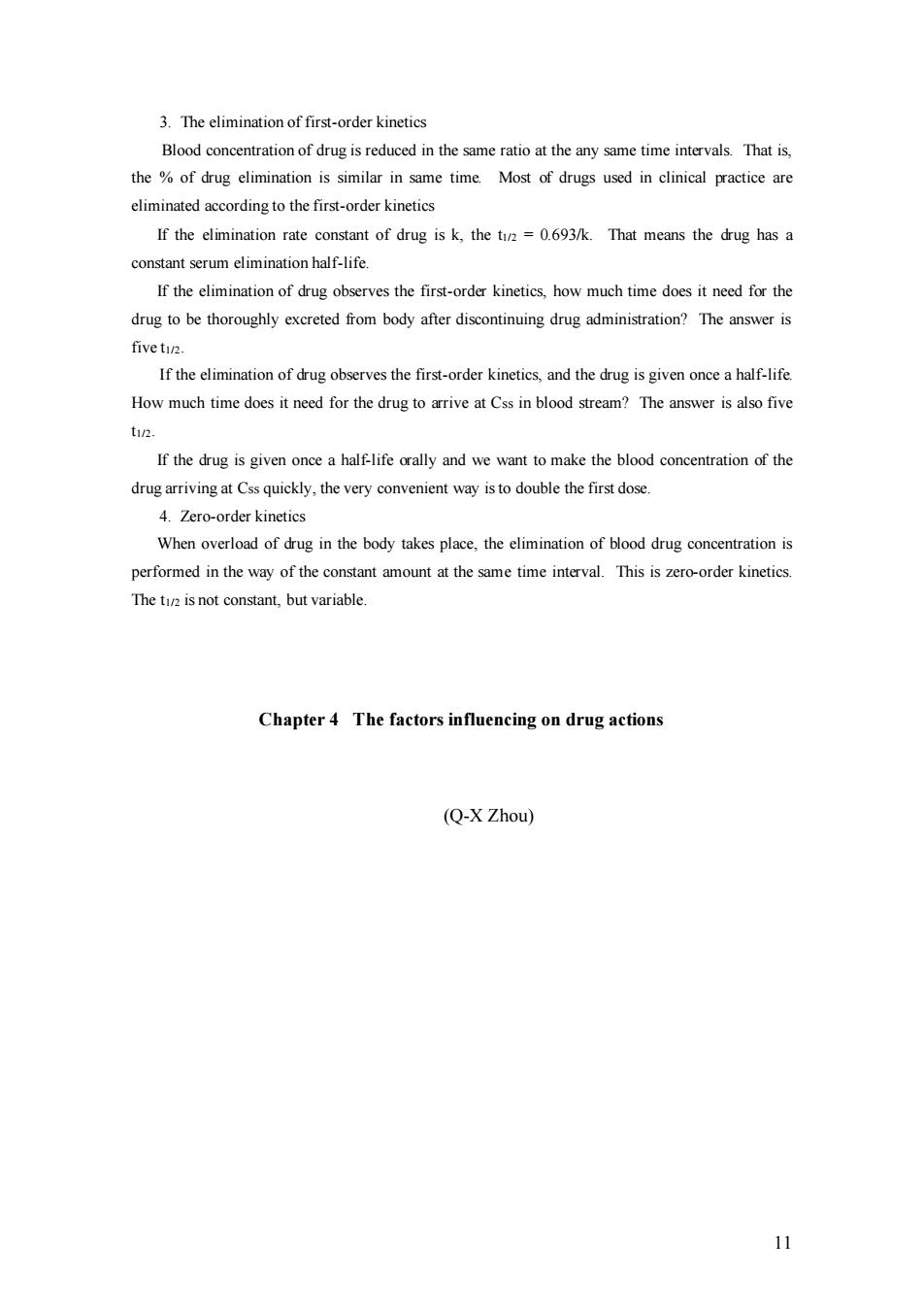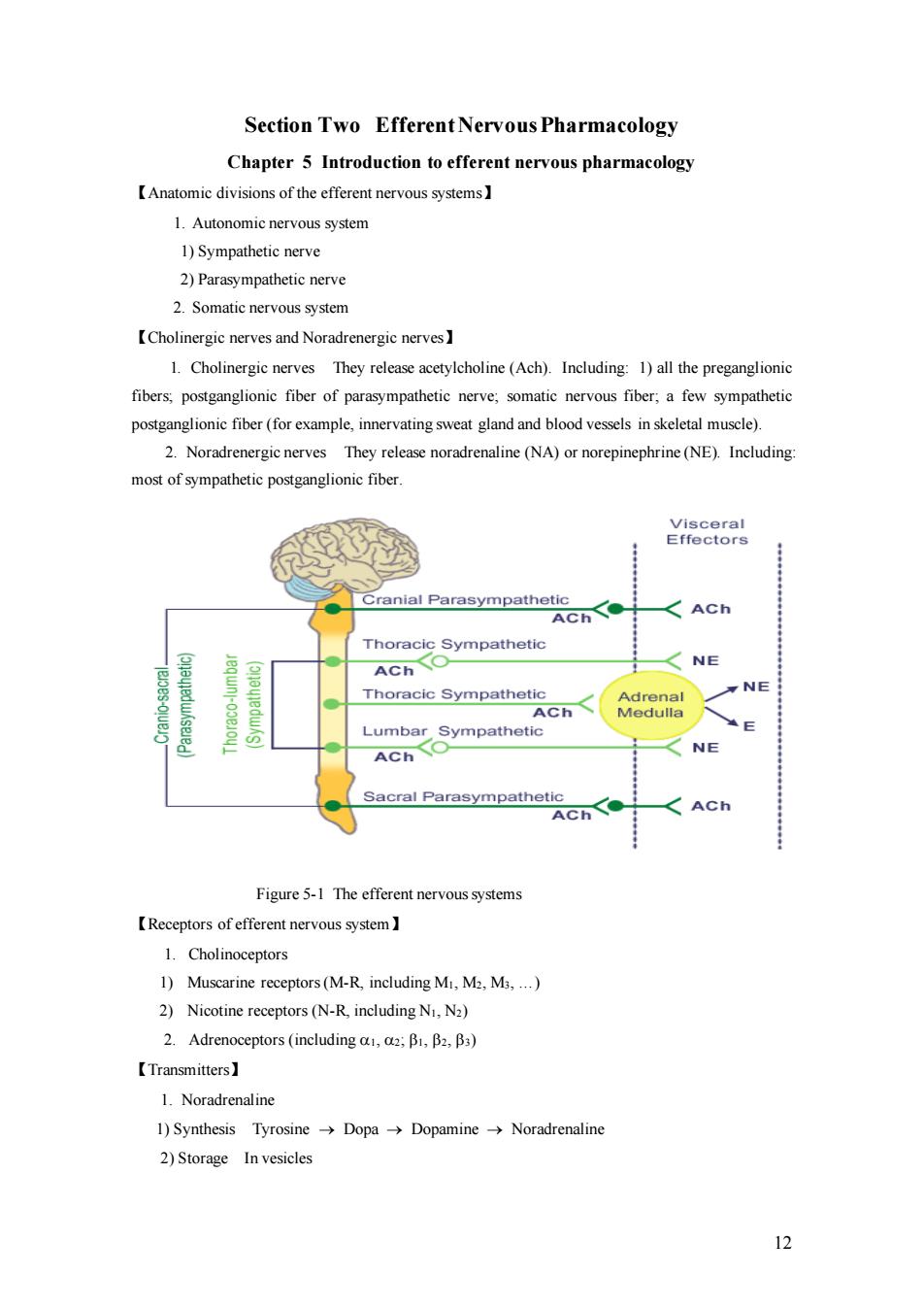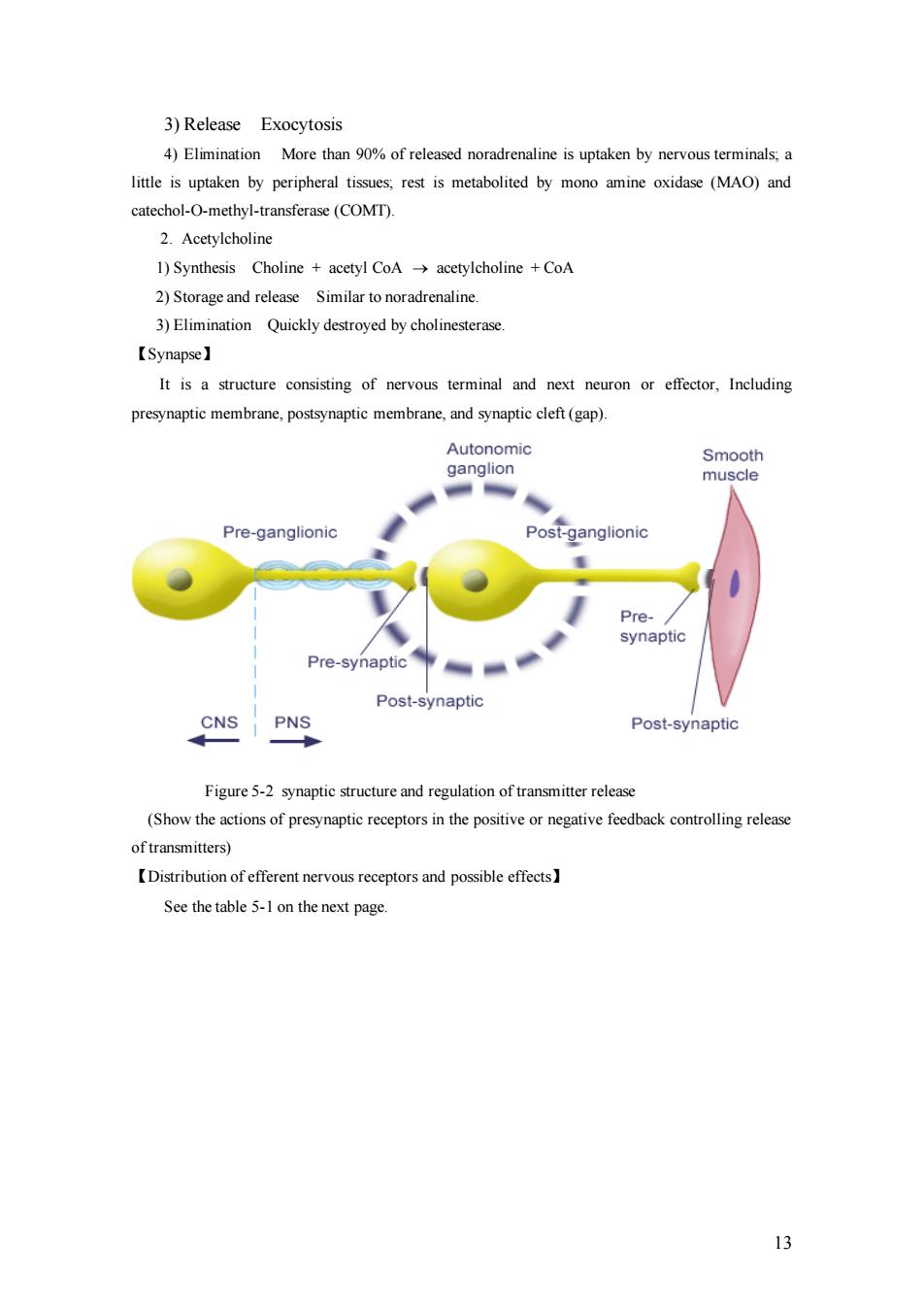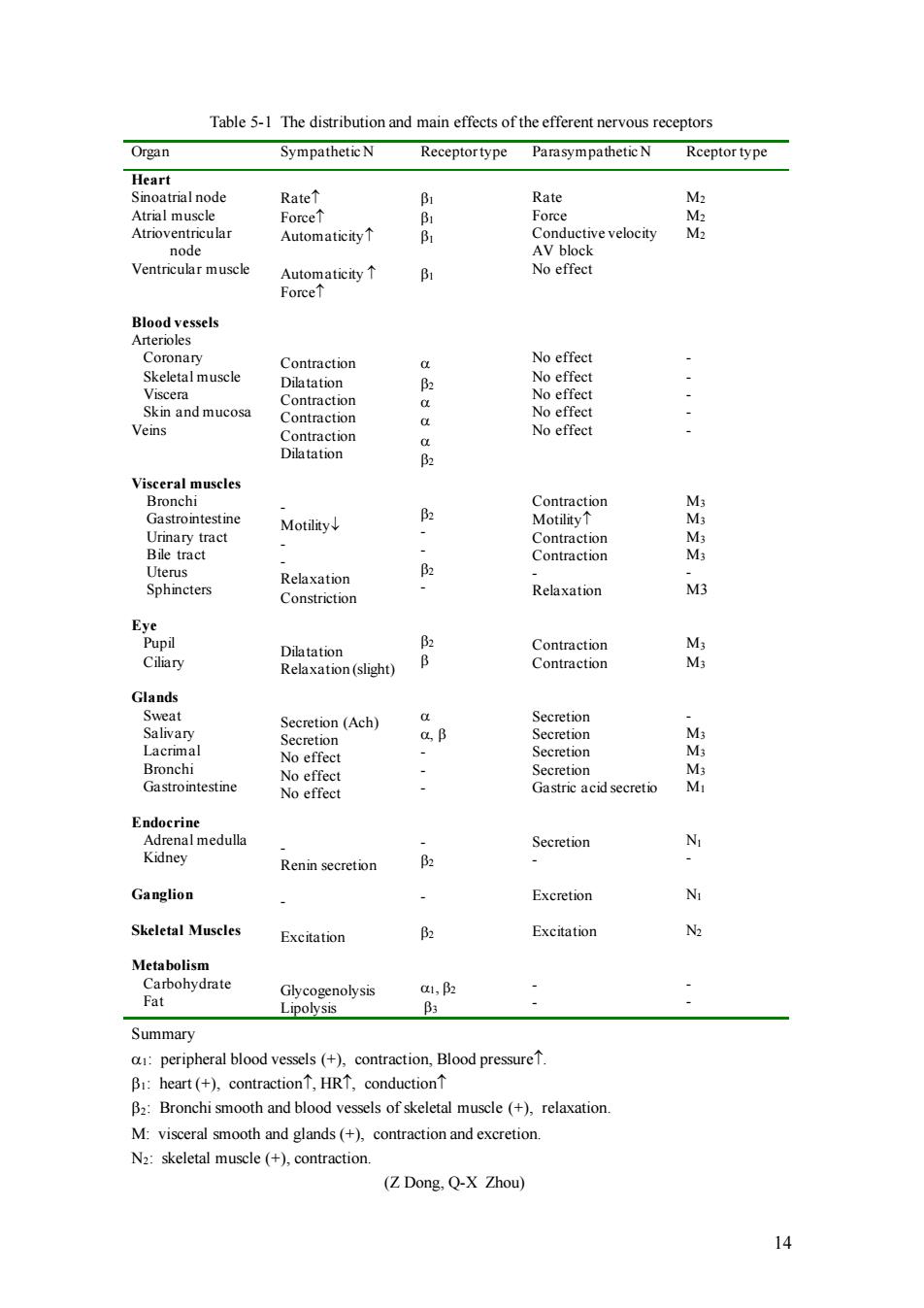
3.The elimination of first-order kinetics of drug isreduced in the any same time intrvals.That is the %of drug elimination is similar in same time.Most of drugs used in clinical practice are eliminated accordingto the firstorder kinetics If the elimination rate constant of drug is k,the t=0.693/k.That means the drug has a If the elimination of drug observes the first-order kinetics,how much time does it need for the drug to be thoroughly excreted from body after discontinuing drug administration?The answer is five t. If the elimination of rugobserves the first-order kinetics,and the drug is given half-life How much time does it need for the drug to arrive at Css in blood stream?The answer is also five tup2. If the drug is given onceahalf-liferally and we want to make the blood conc entration of the drug arriving at Css quickly,the very convenient way is to double the first dose 4.Zero-order kinetics When overload of drug in the body takes place.the elimination of blood drug concentration is peformed in the way of the constant amount at the same time intrval.This is kinetics. The tuz is not constant.but variable Chapter 4 The factors influencing on drug actions (Q-XZhou) 11
11 3. The elimination of first-order kinetics Blood concentration of drug is reduced in the same ratio at the any same time intervals. That is, the % of drug elimination is similar in same time. Most of drugs used in clinical practice are eliminated according to the first-order kinetics If the elimination rate constant of drug is k, the t1/2 = 0.693/k. That means the drug has a constant serum elimination half-life. If the elimination of drug observes the first-order kinetics, how much time does it need for the drug to be thoroughly excreted from body after discontinuing drug administration? The answer is five t1/2. If the elimination of drug observes the first-order kinetics, and the drug is given once a half-life. How much time does it need for the drug to arrive at Css in blood stream? The answer is also five t1/2. If the drug is given once a half-life orally and we want to make the blood concentration of the drug arriving at Css quickly, the very convenient way is to double the first dose. 4. Zero-order kinetics When overload of drug in the body takes place, the elimination of blood drug concentration is performed in the way of the constant amount at the same time interval. This is zero-order kinetics. The t1/2 is not constant, but variable. Chapter 4 The factors influencing on drug actions (Q-X Zhou)

Section Two Efferent Nervous Pharmacology Chapter 5 Introduction to efferent nervous pharmacology [Anatomic divisions of the efferent nervous systems] 1.Autonomic nervous system 1)Sympathetic nerve 2)Parasympathetic nerve 2.Somatic nervous system ICholinergic nerves and Noradrenergic nerves] 1.Cholinergic nerves They release acetylcholine(Ach).Including:1)all the preganglionic fibers,postganglionic fiber of parasympathetic nerve,somatic nervous fiber,a few sympathetic postganglionic fiber(for exampe innervating sweat gland and blood vessels in skeletal muscle). 2.Noradrenergic nerves They release noradrenaline(NA)or norepinephrine(NE).Including most of sympathetic postganglionic fiber. Cranial Parasympathetic ACh Thoracic Sympathetic ACh NE Thoracic Sympathetic NE ACh NE Sacral Parasympathetic Figure 5-1 The efferent nervous systems 【Receptors of efferent nervous system】 1.Cholinoceptors 1)Muscarine receptors(M-R,including M,M2,M,) 2)Nicotine receptors(N-R,including N,N2) 2.Adrenoceptors(includingBB2B) 【Transmitters】 1.Noradrenaline l)Synthesis Tyrosine→Dopa→Dopamine→Noradrenaline 2)Storage In vesicles 12
12 Section Two Efferent Nervous Pharmacology Chapter 5 Introduction to efferent nervous pharmacology 【Anatomic divisions of the efferent nervous systems】 1. Autonomic nervous system 1) Sympathetic nerve 2) Parasympathetic nerve 2. Somatic nervous system 【Cholinergic nerves and Noradrenergic nerves】 1. Cholinergic nerves They release acetylcholine (Ach). Including: 1) all the preganglionic fibers; postganglionic fiber of parasympathetic nerve; somatic nervous fiber; a few sympathetic postganglionic fiber (for example, innervating sweat gland and blood vessels in skeletal muscle). 2. Noradrenergic nerves They release noradrenaline (NA) or norepinephrine (NE). Including: most of sympathetic postganglionic fiber. Figure 5-1 The efferent nervous systems 【Receptors of efferent nervous system】 1. Cholinoceptors 1) Muscarine receptors (M-R, including M1, M2, M3, .) 2) Nicotine receptors (N-R, including N1, N2) 2. Adrenoceptors (including 1, 2; 1, 2, 3) 【Transmitters】 1. Noradrenaline 1) Synthesis Tyrosine → Dopa → Dopamine → Noradrenaline 2) Storage In vesicles

3)Release Exocytosis 4)Elimination More than90%of released noradrenaline is uptaken by nervous terminals;a little is uptaken by peripheral tissues,rest is metabolited by mono amine oxidase (MAO)and catechol-O-methyl-transferase (COMT). 2.Acetylcholine 1)Synthesis Choline acetyl CoA acetylcholine +CoA 2)Storage and release Similar to noradrenaline. 3)Elimination Quickly destroyed by cholinesterase 【Synapse】 It is a structure consisting of nervous terminal and next neuron or effector,Including presynaptic membrane,postsynaptic membrane,and synaptic cleft(gap). Autono Smooth Pre-ganglionic Post-ganglionic synaptic Pre-synaptic CNS PNS Post-synaptic Post-synaptic Figure 5-2 synaptic structure and regulation oftransmitter release (Show the actions of presynaptic receptors in the positive or negative feedback controlling release oftransmitters) Distribution of efferent nervous receptors and possible effects See the table 5-1 on the next page
13 3) Release Exocytosis 4) Elimination More than 90% of released noradrenaline is uptaken by nervous terminals; a little is uptaken by peripheral tissues; rest is metabolited by mono amine oxidase (MAO) and catechol-O-methyl-transferase (COMT). 2. Acetylcholine 1) Synthesis Choline + acetyl CoA → acetylcholine + CoA 2) Storage and release Similar to noradrenaline. 3) Elimination Quickly destroyed by cholinesterase. 【Synapse】 It is a structure consisting of nervous terminal and next neuron or effector, Including presynaptic membrane, postsynaptic membrane, and synaptic cleft (gap). Figure 5-2 synaptic structure and regulation of transmitter release (Show the actions of presynaptic receptors in the positive or negative feedback controlling release of transmitters) 【Distribution of efferent nervous receptors and possible effects】 See the table 5-1 on the next page

Table 5-1 The distribution and main effects of the efferent nervous receptors Organ Sympathetic N Receptortype Parasympathetic N Reeptor type Heart Snoatialnodc RateT B. onductive velocity Ventriculr muscle No effect Blood vessels Coronary Contraction No effect Skeletal muscle Skin and mucosa Veins No effect Dilatation Contrac astrointestine Motility B Sphincters Relaxation Constriction Relaxation M3 Contraction Ciliary on(slight) Contraction Glands Salivary Secretion (Ach) No effec Gastrointestine 、 Gastric acid secretio M Endocrine Secretion Renin secretion Ganglion Excretion N Skeletal Muscles Excitation Excitation Metabolism Lipolysis Summary B2:Bronchi smooth and blood vessels of skeletal muscle (+)relaxation. M:visceral smooth and glands (+)contraction and excretion. N2:skeletal muscle(+).contraction (Z Dong.Q-X Zhou) 14
14 Table 5-1 The distribution and main effects of the efferent nervous receptors Organ Sympathetic N Receptor type Parasympathetic N Rceptor type Heart Sinoatrial node Atrial muscle Atrioventricular node Ventricular muscle Blood vessels Arterioles Coronary Skeletal muscle Viscera Skin and mucosa Veins Visceral muscles Bronchi Gastrointestine Urinary tract Bile tract Uterus Sphincters Eye Pupil Ciliary Glands Sweat Salivary Lacrimal Bronchi Gastrointestine Endocrine Adrenal medulla Kidney Ganglion Skeletal Muscles Metabolism Carbohydrate Fat Rate Force Automaticity Automaticity Force Contraction Dilatation Contraction Contraction Contraction Dilatation - Motility - - Relaxation Constriction Dilatation Relaxation (slight) Secretion (Ach) Secretion No effect No effect No effect - Renin secretion - Excitation Glycogenolysis Lipolysis 1 1 1 1 2 2 2 - - 2 - 2 , - - - - 2 - 2 1, 2 3 Rate Force Conductive velocity AV block No effect No effect No effect No effect No effect No effect Contraction Motility Contraction Contraction - Relaxation Contraction Contraction Secretion Secretion Secretion Secretion Gastric acid secretio Secretion - Excretion Excitation - - M2 M2 M2 - - - - - M3 M3 M3 M3 - M3 M3 M3 - M3 M3 M3 M1 N1 - N1 N2 - - Summary 1: peripheral blood vessels (+), contraction, Blood pressure. 1: heart (+), contraction, HR, conduction 2: Bronchi smooth and blood vessels of skeletal muscle (+), relaxation. M: visceral smooth and glands (+), contraction and excretion. N2: skeletal muscle (+), contraction. (Z Dong, Q-X Zhou)

Chapter 6 Cholinomimetics (Parasympathomimetics,Cholinergic agonists) Cholinomimetics have resembling effects of acetylcholine.That means they 'imitate'or pretend'the actions of acetylcholine by the direct or indirect ways.This group drugs consist of muscarine receptor agonists (M-R agonists).nicotine receptor agonists (N-R agonists),and cholinesterase inhibitors(ChE D).However,in clinical practice,only M-R agonists and ChE Iare used for special purposes. Pilocarpine [pilouk:pin] 【History and chemistry】 Pilocarpine is a tertiary amine alkaloid which originally isolated from the leaves of Pilocarpus Jaborandi in South American in 1871.It is prepared synthetically now and used as pilocarpine nitrate. 【Properties of pharmacology】 Pilocarpine is a strong M-R agonist with wide permeability of the tissues.So it is only topically used for treatment of glaucoma to decrease intraocular pressure 【Mechanism of action】 Stimulate M-R on the sphincter muscle of irisrapid miosisanterior chamber comner is widened→drainage of aqueous humor↑→intraocular pressure↓ 【Adverse effects】 1.It stimulates M-R on the ciliary muscle and makes spasm of eye accommodation 2.If the drug is absorbed it will produce systemic effects including sweating.secretion of salivary and bronchi glands,and intensification of gastrointestinal peristalsis,even cause CNS disturbances when entering the brain. Neostigmine[ousin]bromide,or methylsulfate 【Chemistry and history】 Neostigmine is a synthetie quaternary nitrogen ion compound (1933)with carbamic portion (block ChE)and choline portion(stimulate N2-R). 【Properties of pharmacology】 1.Poor penetration and erratic absorption after given orally. 2.Cholinomimetic actions involve in several aspects:directly stimulate N2-R of neuromuscular junction.promote the release of Ach from the somtic nervous ends,reversiblly inhibit ChE activity. Obviously,the selective target tissue of neostigmine is skeletal muscle. 【Indication】 1.Neostigmine bromide,or methylsulfate can be used to treat mild myasthenia gravis combines with corticosteroids or other immunosuppressors for treating moderate to severe 15
15 Chapter 6 Cholinomimetics (Parasympathomimetics, Cholinergic agonists) Cholinomimetics have resembling effects of acetylcholine. That means they ‘imitate’ or ‘pretend’ the actions of acetylcholine by the direct or indirect ways. This group drugs consist of muscarine receptor agonists (M-R agonists), nicotine receptor agonists (N-R agonists), and cholinesterase inhibitors (ChE I). However, in clinical practice, only M-R agonists and ChE I are used for special purposes. Pilocarpine [pilouk:pin] 【History and chemistry】 Pilocarpine is a tertiary amine alkaloid, which originally isolated from the leaves of Pilocarpus Jaborandi in South American in 1871. It is prepared synthetically now and used as pilocarpine nitrate. 【Properties of pharmacology】 Pilocarpine is a strong M-R agonist with wide permeability of the tissues. So it is only topically used for treatment of glaucoma to decrease intraocular pressure. 【Mechanism of action】 Stimulate M-R on the sphincter muscle of iris → rapid miosis → anterior chamber corner is widened → drainage of aqueous humor → intraocular pressure . 【Adverse effects】 1. It stimulates M-R on the ciliary muscle and makes spasm of eye accommodation. 2. If the drug is absorbed it will produce systemic effects including sweating, secretion of salivary and bronchi glands, and intensification of gastrointestinal peristalsis, even cause CNS disturbances when entering the brain. Neostigmine[ni:oustigmin] bromide, or methylsulfate 【Chemistry and history】 Neostigmine is a synthetic quaternary nitrogen ion compound (1933) with carbamic portion (block ChE) and choline portion (stimulate N2-R). 【Properties of pharmacology】 1. Poor penetration and erratic absorption after given orally. 2. Cholinomimetic actions involve in several aspects: directly stimulate N2-R of neuromuscular junction; promote the release of Ach from the somatic nervous ends; reversiblly inhibit ChE activity. Obviously, the selective target tissue of neostigmine is skeletal muscle. 【Indication】 1. Neostigmine bromide, or methylsulfate can be used to treat mild myasthenia gravis; it also combines with corticosteroids or other immunosuppressors for treating moderate to severe